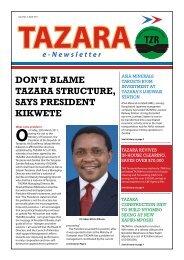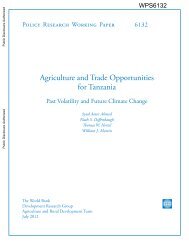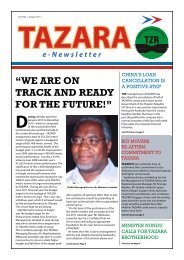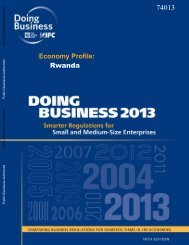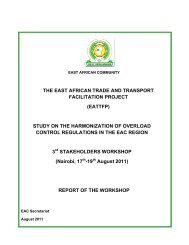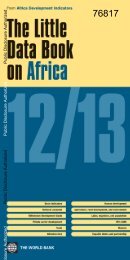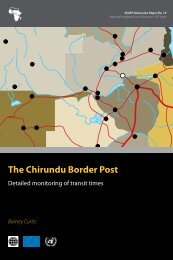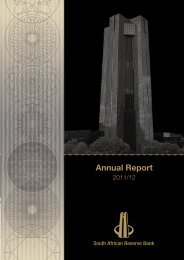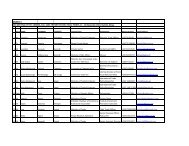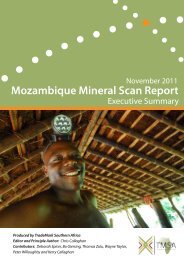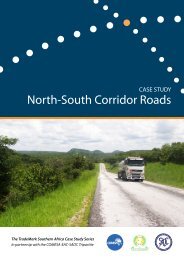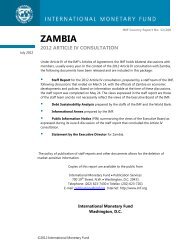Nacala Road Corridor - TradeMark Southern Africa
Nacala Road Corridor - TradeMark Southern Africa
Nacala Road Corridor - TradeMark Southern Africa
- No tags were found...
You also want an ePaper? Increase the reach of your titles
YUMPU automatically turns print PDFs into web optimized ePapers that Google loves.
consistency with specifications; (vi) road safety measures have not always been adequatelyaddressed; (vii) lack of implementation of HIV/AIDS awareness campaigns as planned; and (viii)as in most countries, lack of adequate routine and periodic maintenance of road assets pose aserious threat to the expected life span of rehabilitated road assets; (ix) regional coordination andmonitoring by corridor authorities and Regional Economic Communities (RECs) is required toovercome fragmented approaches at the country level and improve operational practices for thecorridor as a whole. Conflicts between national strategies and regional strategies could occur andthe coordinating role of <strong>Corridor</strong> committees and RECs is crucial; (x) institutional capacity buildingis essential in order to implement large scale corridor projects; (xi) best practice cross bordertransport projects have several elements in order to enhance the impact, including transportinfrastructure development, trade facilitation and regulatory reforms.2.9 Key Performance Indicators2.9.1 The achievement of the Project objectives will produce the following outcomes: (i) reducedtransport cost and improved accessibility of communities to social services and markets; and (ii)improved road safety. In an attempt to reduce the reporting demands on RDA for the overall NCRPPhase II, the Project performance indicators have been standardized and harmonized with those ofthe EU and EIB to the largest extent possible. These basic indicators for monitoring and evaluatingProject outcomes are included in the Project Results Framework. The outcome and impactindicators will be reviewed at the start of Project implementation and include: (i) VOC savings andtravel time cost; (ii) service levels of road over design life and road condition; and (iii) trafficaccidents and mortality along the Transport Project (annually). Other socio-economic outcomeindicators that are directly influenced by the Project, such as income levels; and production of keyagricultural crops in Eastern Province will also be monitored.3.1. Economic and financial performanceIII – PROJECT FEASIBILITY3.1.1 The economic viability of NRCP, Phase II and the Project has been assessed within the CostBenefit Analysis framework of the <strong>Road</strong> Economic Decision (RED) Model. The model allowsmodelling over the analysis period of 20 years and compares the annual streams of economiccapital and operating cost and benefits and computes the Net Present Value (NPV) and the EIRR,based on the 12% opportunity cost of capital in Zambia. Financial costs were converted intoeconomic cost by applying a standard conversion factor (SFC) of 0.8. The economic benefits arecalculated as the difference between the “with the Project” and the “without the Project” scenarios.3.1.2 The viability of the Project rests primarily on the improved road conditions generatingsavings to road users in the form of reduced Vehicle Operating Cost (VOC) savings and timesavings for normal, generated and diverted traffic, constituting 56% of benefits. It is also assumedthat reductions in road user cost and increased confidence in the <strong>Nacala</strong> <strong>Road</strong> <strong>Corridor</strong> as a viableexport route will result in increased production and sales of agricultural produce. The EasternProvince is one of the most agriculturally productive provinces in Zambia and accounts for morethan 25% of the value of the country’s total agricultural production. NRCP, Phase II is the onlyaccess point from the Province to the rest of the country. The benefits assumed resulting from this“producer surplus” are estimated at 27.4%. The road safety design measures and the road safetyawareness campaigns included in the Project are estimated to result in significant reductions in roadaccidents and fatalities. The benefits from reductions in road accidents are estimated at 9%. Finally,the benefits to the road agency consist of maintenance savings, estimated at 6.2% of total benefits11




